We Asked Gardening Pros If You Should Rake Leaves From Garden Beds—And They All Agreed
The Spruce – Heather Zidack and other professionals give their insight on raking leaves from your garden beds.
Web cookies (also called HTTP cookies, browser cookies, or simply cookies) are small pieces of data that websites store on your device (computer, phone, etc.) through your web browser. They are used to remember information about you and your interactions with the site.
Session Management:
Keeping you logged in
Remembering items in a shopping cart
Saving language or theme preferences
Personalization:
Tailoring content or ads based on your previous activity
Tracking & Analytics:
Monitoring browsing behavior for analytics or marketing purposes
Session Cookies:
Temporary; deleted when you close your browser
Used for things like keeping you logged in during a single session
Persistent Cookies:
Stored on your device until they expire or are manually deleted
Used for remembering login credentials, settings, etc.
First-Party Cookies:
Set by the website you're visiting directly
Third-Party Cookies:
Set by other domains (usually advertisers) embedded in the website
Commonly used for tracking across multiple sites
Authentication cookies are a special type of web cookie used to identify and verify a user after they log in to a website or web application.
Once you log in to a site, the server creates an authentication cookie and sends it to your browser. This cookie:
Proves to the website that you're logged in
Prevents you from having to log in again on every page you visit
Can persist across sessions if you select "Remember me"
Typically, it contains:
A unique session ID (not your actual password)
Optional metadata (e.g., expiration time, security flags)
Analytics cookies are cookies used to collect data about how visitors interact with a website. Their primary purpose is to help website owners understand and improve user experience by analyzing things like:
How users navigate the site
Which pages are most/least visited
How long users stay on each page
What device, browser, or location the user is from
Some examples of data analytics cookies may collect:
Page views and time spent on pages
Click paths (how users move from page to page)
Bounce rate (users who leave without interacting)
User demographics (location, language, device)
Referring websites (how users arrived at the site)
Here’s how you can disable cookies in common browsers:
Open Chrome and click the three vertical dots in the top-right corner.
Go to Settings > Privacy and security > Cookies and other site data.
Choose your preferred option:
Block all cookies (not recommended, can break most websites).
Block third-party cookies (can block ads and tracking cookies).
Open Firefox and click the three horizontal lines in the top-right corner.
Go to Settings > Privacy & Security.
Under the Enhanced Tracking Protection section, choose Strict to block most cookies or Custom to manually choose which cookies to block.
Open Safari and click Safari in the top-left corner of the screen.
Go to Preferences > Privacy.
Check Block all cookies to stop all cookies, or select options to block third-party cookies.
Open Edge and click the three horizontal dots in the top-right corner.
Go to Settings > Privacy, search, and services > Cookies and site permissions.
Select your cookie settings from there, including blocking all cookies or blocking third-party cookies.
For Safari on iOS: Go to Settings > Safari > Privacy & Security > Block All Cookies.
For Chrome on Android: Open the app, tap the three dots, go to Settings > Privacy and security > Cookies.
Disabling cookies can make your online experience more difficult. Some websites may not load properly, or you may be logged out frequently. Also, certain features may not work as expected.
We Asked Gardening Pros If You Should Rake Leaves From Garden Beds—And They All Agreed
The Spruce – Heather Zidack and other professionals give their insight on raking leaves from your garden beds.
By Dawn Pettinelli, UConn Home & Garden Education Center
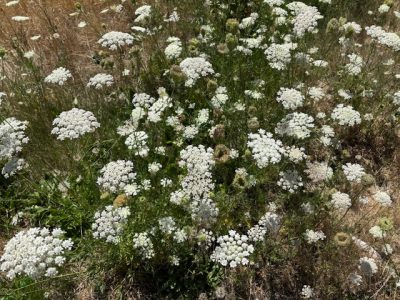
Among the plants that have naturalized across this country, is the seemingly ubiquitous Queen Anne’s lace also known as the wild carrot. This herbaceous biennial originated around the Mediterranean region and western Asia. It is thought to be a wild ancestor of the carrot as both wild and domesticated carrots existed at least 5000 years ago. Anyone weeding or digging out Queen Anne’s lace from garden beds will notice the distinctive carrot smell of the taproots.
Pass almost any sunny roadside or field and you’ll find the delicate white lacy blossoms swaying in the breeze. Plants start out as small rosettes of fern-like, green leaves. The seeds can germinate throughout the growing season if enough moisture is present. Typically seeds germinate within a couple of years but they can remain viable for at least 7 years. A taproot develops where energy is stored for next year’s growth. The following spring, the plant produces more leaves, stalks and flowers. The lacy leaves are finely divided and tripinnate. The hairy, solid stem can grow up to 3 feet before the flower buds are formed.
Queen Anne’s lace blossoms typically appear from June through August in most areas. The tiny white flowers are clustered into a flat, terminal umbel from 2 to 4 inches across. Curiously, many flower heads have a single pinkish to purplish floret in the center. The color is due to the pigment, anthocyanin. For at least 150 years, botanists have been trying to figure out what purpose the dark colored floret serves. It is thought that perhaps it serves as an insect attractant but this remains to be confirmed.
Each floret on the umbel can produce 2 seeds. Since there might be 1000 florets making up the umbel, saying this plant is a prolific seeder is an understatement. In at least 35 states, it is considered a noxious weed as it displaces native vegetation. As the seeds ripen, the flower head curls inward like a closed fist or bird’s nest and turns brown. Eventually the dried seed head might detach from the stem and then it can be blown like a tumbleweed spreading its cache. This plant is especially problematic if it occurs where domesticated carrots are grown for their seed. Cross pollination could take place and the resulting seed would be useless. The seeds have hooked spines and can readily attach to cloth and fur.

Aside from its lovely, lacy flowers that hold up well in cut flower arrangements, Queen Anne’s lace serves as a host plant for the eastern black swallowtail caterpillar as well as providing a source of nectar for other butterfly species, bees and other pollinators.
Several seed companies offer varieties of Queen Anne’s lace that were bred or selected for their dark coloration. ‘Purple Kisses’ sports umbels in shades of dark purple and pink and is available from Johnny’s Seed. ‘Chocolate Lace’ from Seed Therapy comes in shades of burgundy, chocolate and dusty rose. Although I have not grown these varieties, I suspect they would also self-seed. A better option might be to try Ammi majus, called the Bishop’s flower or False Queen Anne’s lace. It is an annual with similar lacy, white flowers but I have not found it to be a prolific seeder especially if the flowers are used for cutting and not left to go to seed.
Being a member of the parsley (Apiaceae) family, Queen Anne’s lace is edible but not very flavorful. The flowers are sometimes used to make jelly. The root could be eaten when young but gets tough very fast. The seeds especially have been used for medicinal purposes for centuries. Reputedly this aromatic herb has many uses ranging from a love potion to soothing the digestive system, supporting the liver and for kidney and bladder diseases. If you are tempted to sample some Queen Anne’s lace, be very careful to identify it correctly. Other plants, such as poison hemlock have similar flowers and foliage but deadly outcomes.
As to how Queen Anne’s lace got its name, there are a number of anecdotes. Perhaps it resembled the lace collar or headdress of Queen Anne (1655-1714). Another story goes that she was tatting lace and pricked her figure leaving a drop of blood on the lace, representing the dark floret. Or it could be that the dark floret was thought to be the Queen and the white ones her maids. Geoffrey Grigson, an English botanist, conjectured that the name was in honor of St. Anne, the mother of the Virgin Mary and the patron saint of lacemakers.
However Queen Anne’s lace got its name, one has to be in awe of how widespread it has become. Because plants are short-lived but prolific seeders, one way to control it is to remove the flower heads before they go to seed. They do make delightful cut flowers so make use of them in arrangements. You get to enjoy them and there is less seed out there.
The UConn Home & Garden Education Center supports UConn Extension’s mission by providing answers you can trust with research-based information and resources. For gardening questions, contact us toll-free at (877) 486-6271, visit our website at homegarden.cahnr.uconn.edu, or reach out to your local UConn Extension center at cahnr.uconn.edu/extension/locations.
This article was published in the Hartford Courant August 23, 2025
By Pamm Cooper, UConn Home and Garden Education Center
Every spring I make a list of the plants that hummingbirds visited the most the year before, and then my search at garden centers and nurseries begins in earnest. The plants I look for are the ones that not only hummingbirds seem to benefit from the most, but also the ones that bloom the longest. I also select the plants whose flowers I enjoy as well.
Although annuals generally have the longest bloom time, there are some perennial ornamentals that are very attractive to hummingbirds and are worth considering for a garden or a landscape. Including a small group of these plants would be a great benefit to hummingbirds as they visit your property.
Obedient plants, Physostegia virginiana, can bloom from early June through September. These drought tolerant perennials may get 3 feet tall and some will slowly spread. If that trait is a problem, The ‘Manners’ series such as the white ‘Miss Manners’ obedient plants are not spreaders. The flowers are also attractive to butterflies, especially tiger swallowtails, and pollinators.
Native swamp milkweed, Asclepias incarnata, is also visited by hummingbirds. This plant likes moister soils than most milkweed, and mine is planted near a birdbath that gets emptied frequently to add fresh water. This milkweed, along with butterfly weed A. tuberosa, can be deadheaded to promote rebloom.
Hyssops, Agastache spp., are also a favorite of hummingbirds, and most have a long bloom period, some starting in late spring. The ‘Kudos’ series with small flowers that are yellow, pink or orange are the ones visited the most by hummingbirds on my property. Another favorite is ‘Boa’, which has larger flower spikes lasting a good three months. Deadheading all will prolong bloom time.
Annual flowering plants that are a favorite of hummingbirds include Salvias, cardinal climber, Fuschias, Lantanas and Cupheas. All are easy to grow, and all but the cardinal vine can be used in containers, hangers and window boxes.
The cardinal climber, Ipomena x multifida, is an attractive, fast-growing annual vine that has small, brilliant red trumpet- like flowers. You can save seeds from this plant and use them next year. One plant can grow to fill a large trellis, and you may need to corral it in if it starts reaching out for nearby plants.
Of the Cupheas, the ones most visited, in my experience, are the large firecracker plant, C. vermillionaire, and the smaller one, C. schumannii, also called the orange cigar plant. The former is superior, with a compact, mounding habit and continuous bloom of orange tubular flowers until frost. If the smaller cigar plant is planted directly in the garden, give it some room as it sprawls somewhat.
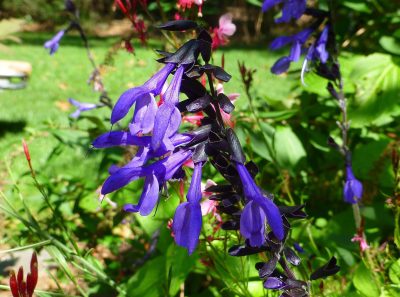
Annual Salvias like the “Rockin’ series, the ‘Black and Blue’, ‘Roman Red’ and the ‘Hot Lips’ salvias are the ones I always have in my containers or plant directly in the ground in spaces I leave for them. I would not venture to guess which ones hummingbird prefer, as they visit all of these throughout the day.
There are a couple of shrubs that I learned by chance observance are favorites of hummingbirds. These are Weigelas, and butterfly bushes, Buddleia davidii. There are Weigelas that bloom only in the spring, some that bloom in spring and then again later in the summer through fall, like the ‘Sonic Blooms’, and some that bloom throughout the year, like ‘Crimson Kisses’ and ‘ Peach Kisses’. The last two are smaller shrubs which have a rounded habit.
The plants I have included in this brief article are only a small example of plants that the average gardener can include on their property in gardens or containers of some type. I will mention that while I do have a hummingbird feeder, the hummers I see are favoring actual flowers over that source of food. Downy woodpeckers and orioles do visit the feeder instead, so it is useful to them, I guess. I may start calling it my downy feeder, at least during the summer.
The UConn Home & Garden Education Center supports UConn Extension’s mission by providing answers you can trust with research-based information and resources. For gardening questions, contact us toll-free at (877) 486-6271, visit our website at homegarden.cahnr.uconn.edu, or reach out to your local UConn Extension center at cahnr.uconn.edu/extension/locations.
This article was published in the Hartford Courant July 26, 2025
Nick Goltz, DPM, UConn Home & Garden Education Center, UConn Plant Diagnostic Lab
When I moved to Connecticut in July of 2021, I remember driving through neighborhoods looking for somewhere I might eventually want to live and being struck by the beautifully-landscaped yards that each home seemed to showcase. I particularly remember being impressed by the tidy hedges of hydrangea, filled with lush globes of blue, pink and purple flowers. Can you think of a flower more emblematic of breezy, long summer days by New England coast than the hydrangea? I’ll wait.
Hydrangeas are a fascinating group of perennial plants with some unique quirks that make them a fun addition for the home garden. The genus is native to Asia and North America, but the species grown most commonly around the world, Hydrangea macrophylla, is native to Japan and has been bred extensively for hundreds of years, resulting in many cultivars. They are also bred with other species to help select for cold tolerance or inflorescence (flower cluster) shape.
Hydrangea macrophylla are commonly known as “bigleaf hydrangea”, but may also be called “lacecap” or “mophead” hydrangea, depending on the shape of the cultivar’s inflorescence. While many species of hydrangeas have white flowers, bigleaf hydrangeas are prized for their beautiful inflorescences that act as a natural pH indicator of the soil the plants grow in. The petals of flowers will change depending on how basic or acidic the soil is. Flowers will be blue, indigo, or deep purple in acidic soils with a pH of 5.5 or less. Plants gown in a slightly acidic soil with a pH between 5.5 and 6.5 will have a mix of purple hues. Hydrangeas grown in neutral to basic soils with a pH greater than 6.5 (especially 7 and up) will generally have fuchsia to pink-colored flowers. Many gardeners will amend the soil of their hydrangea beds from year to year to achieve the color that they hope for.
Many folks know of the color-changing capabilities of hydrangeas, but keep reading for a few tips on how to properly care for them beyond adjusting soil pH. Hydrangeas prefer moist, well-draining soil and a sheltered spot with partial shade. Some cultivars tolerate full sun well, but must be watered consistently to look their best. Hydrangeas do not grow exceptionally large and are considered “low fire risk”, so are a better choice for planting near the home.
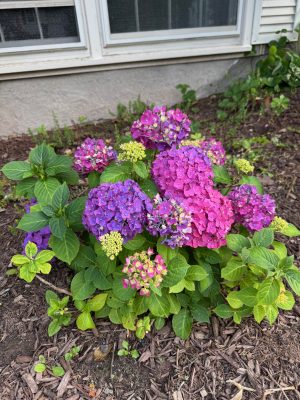
There’s a reason why coastal New England towns seem to be filled with hydrangeas while interior towns, particularly for our friends in Vermont, western Massachusetts, Maine, and New Hampshire, have fewer. Bigleaf hydrangeas can tolerate cold temperatures, but only to an extent. Depending on the cultivar, bigleaf hydrangeas grow best from zones 6 to 8. Most cultivars will survive zone 5 winters, but might not flower well without protection – harsh winter temperatures, especially when paired with low snow cover, can kill flower buds.
Flower buds form on old growth for most cultivars of bigleaf hydrangea. Because of this, many folks will accidentally prune away flower buds in winter, resulting in poor flower production come summer. For this reason, it’s important to never prune bigleaf hydrangea in fall, winter, or spring. Only prune away the bare stems from the previous year when you see that no new growth is being produced from them, or in summer when collecting flowers for the vase on your kitchen table!
If you find the twiggy winter appearance unsightly and can’t help but prune, if you struggle with deer feeding, or if you live in an area with common late spring frosts, consider planting a “reblooming” bigleaf hydrangea. There are a few cultivars, such as ‘Endless Summer’ and sports, that will produce flower buds on old growth and (usually) a second flush on new growth. Alternatively, you could plant other species of hydrangeas, such as smooth hydrangea (Hydrangea arborescens), or panicle hydrangea (Hydrangea paniculata), which tend to be a little more cold-hardy, or oakleaf hydrangea (Hydrangea quercifolia), if you’re looking for a hydrangea for an area with very hot summers.
If you have questions about growing hydrangeas, or any other gardening topic, call the UConn Home & Garden Education Center (toll-free) at (877) 486-6271. You can also email us at ladybug@uconn.edu, visit our website, www.homegarden.cahnr.uconn.edu, or visit your local UConn Cooperative Extension center.
This article was published in the Hartford Courant and The Westerly Sun July 5, 2025
By Dawn Pettinelli, UConn Home & Garden Education Center
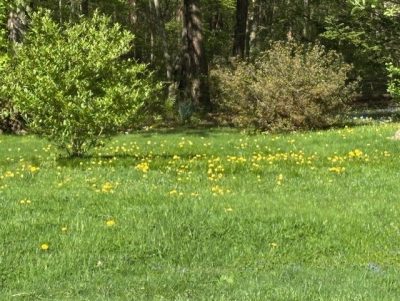
For many, the sight of a lush green lawn brings about the desire to cast off one’s shoes and stroll through the sun-warmed grass feeling the soft verdant carpet below. Lawns, or at least grassy areas, are a ubiquitous part of almost every home outside city limits. While admittedly that perfect lawn is a source of curb appeal and homeowner pride, in recent years considerable attention has been given to the ecological and environmental costs of maintaining turf that is the envy of the neighborhood.
Managed turf grass areas, including golf courses and park areas cover about 8 percent (400 square miles) of the land area in Connecticut. That perfect lawn typically requires supplemental irrigation, fertilizer, regular mowing and often pesticide applications. Water could be better used for drinking, other domestic uses and just left in natural systems. Excess nutrients as well as pesticides can be found in ground and surface waters causing both human health as well as ecosystem problems. While some are turning to electric mowers and blowers, gas-powered equipment dependent more on fossil fuels, are most prevalent (at least in my neighborhood) contributing to climate change.
So what is a residential lawn owner to do? The authors of Redesigning the American Lawn were among the first to coin the term “freedom lawn.” So, what is a freedom lawn? Basically, anything that is green is allowed to grow. That would include dandelions, self-heal, violets, bluets, buttercups, clover and wild strawberries to list a few of those so-called “low growing broad-leaved plants”. By my definition, weeds are plants growing in the wrong place, so the plants are weeds no longer when accepted as part of the lawn.
One of the greatest reasons for encouraging a variety of plants to inhabit turf areas is that the world is facing a critical loss of biodiversity. There are significant declines in beneficial insect, native plant and bird populations, along with other living organisms. While that lush green lawn offers aesthetic pleasure to some, it does little to provide habitat or food for creatures other than problematic ones like grubs or chinch bugs.
A mixed grass- herbaceous plant lawn will contain flowering plants for pollinators and other beneficials. Various plant species have varying root systems. Some have deep taproots that break up compacted soil and bring up minerals. Others have more fibrous root systems that are continuously turning over added organic matter to the soil. A variety of plants along with their root exudates and associated microbes can help aggregate the soil, improving air and water passage. Porosity plus water holding capacity can be increased as well as lessening the potential for topsoil erosion. A healthy plant community usually portends a healthy soil.
Leaning into a freedom or pollinator lawn does not mean digging up one’s entire lawn and reseeding it although that is one option. Two seed mixes that I have seen advertised are Flawn and Fleur de Lawn. Both contain a mixture of fescues, microclover and the latter, some other flowering species. Probably greatest success with these seed mixes would be achieved starting with bare soil.
One can start encouraging biodiversity and pollinator plants by discontinuing the use of herbicides and allowing some flowering plants to move in. Often, they can be mowed before they set seed. When reseeding bare spots, use more drought tolerant fescues or native grasses like little bluestem to reduce the need for irrigation, once established. Higher mowing heights up to 3 or 4 inches will encourage deeper rooting of all plants making them more resilient during periods of drought.
Learn about the benefits of some of the low-growing broad-leaved plants that want to call your lawn home. Clovers add nitrogen to the soil reducing the amount of fertilizer necessary. Violets are host plants for the endangered regal fritillary. Dandelion greens are a great source of vitamins A and C. It is true that many of these plants are not native, but neither are the cool season turf grasses normally found in lawns.
In many yards, keeping part of it in lawn is essential for children’s play and sports activities, pet areas and entertaining. Take a tour of your yard and determine where a lawn makes sense and where it might be more appropriate for woody plants, ornamental beds or even a vegetable garden. Steep slopes or perpetually shaded areas may be best for groundcovers. Areas where water frequently collects after heavy rains might be more suitable for a rain garden.
However small, every effort to encourage biodiversity, provide for our beneficials and improve soil health is a step in the right direction. Rethinking your lawn areas might be a good place to start.
For information on lawns or any other gardening topic, call the UConn Home & Garden Education Center (toll-free) at (877) 486-6271 or email us at ladybug@uconn.edu or visit our website, www.homegarden.cahnr.uconn.edu.
This article was published in the Hartford Courant May 18, 2025
By Heather Zidack, UConn Home & Garden Education Center

Rhododendrons are looking rough this spring. You’ve probably seen it in your yard or in your neighborhood. The UConn Home & Garden Education Center has been seeing an increase in the number of calls regarding injury or damage to rhododendrons. In most cases, we are finding these reports to be winter injury. This is an environmental type of damage, caused by a perfect storm of conditions that we have seen throughout the state. So, let’s take a closer look into why this is happening.
Plants lose water through their leaves. During active growth, that water is constantly replenished from the roots. When the temperatures drop and the ground freezes in the winter, available water becomes limited. Plants have adapted to this in many ways. Dormancy is triggered by multiple factors, but water conservation is certainly one of those. Deciduous trees shed their leaves completely. Evergreens have developed various leaf adaptations to help with survival, too.
As broadleaf evergreens, rhododendrons have developed a waxy coat on their leaves to help prevent water loss. They also have a physiological mechanism to help defend themselves further. Just as you’d clasp your hands together on a cold winter day to shield them from the elements, rhododendron leaves curl themselves into cigar-shaped cylinders. The leading theory is that this happens to protect the leaves from further water loss. This natural defense mechanism has grabbed our attention this spring, since our weather patterns have lent a hand in amplifying a natural phenomenon.
At the end of last summer, CT started to see a moderate drought in much of the state. These conditions have persisted through this spring. Water availability was limited as plants went into the winter and remained limited throughout the season. Add in frozen soil and harsh winter winds and the environmental stress increased even more. When water is unavailable to the roots – through either freezing or drought conditions, plants lose their ability to return water to the living tissues. This drying out, referred to as desiccation, leads to winter injury or winter kill depending on the severity of damage. While we are finally seeing rain, these plants need time to recover and may not be ready to unfurl just yet.
Many have noted that some plants are faring better than others even within the same bed. This is also normal to some extent. It can be easy to forget that plants are living things in our landscapes. There is going to be variance in their ability to withstand environmental pressures and their recovery rates.
If you are seeing this in your rhododendrons, be patient this spring and monitor over the next month or so. With an increase of rain in the forecast, the extra hydration should help plants recover - or at least push out new growth. These shrubs will shed any leaves that are damaged beyond repair on their own. Do not prune or fertilize shrubs until the end of May to avoid further injury. If we go a week without rain, consider watering your shrubs to help speed up recovery – but only water if the soil feels dry to the touch! If by mid-late May you are seeing absolutely no improvement, we start to consider other factors that may contribute to the plant’s health. For now, they just need a little more time.
The UConn Home & Garden Education Center supports UConn Extension’s mission by providing answers you can trust with research-based information and resources. For gardening questions, contact us toll-free at (877) 486-6271, visit our website at homegarden.cahnr.uconn.edu, or reach out to your local UConn Extension center at cahnr.uconn.edu/extension/locations.
This article was published in the Hartford Courant Apr. 12 2025
By Pamm Cooper, UConn Home & Garden Education Center
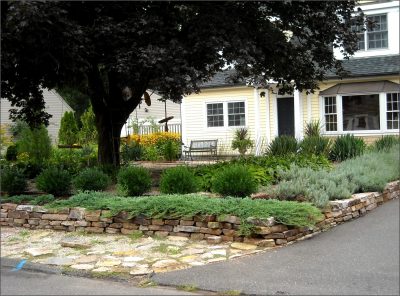
The trend in North America of having a lawn surrounding a house is not a world-wide one. As a matter of fact, it’s only since the 1940s that American lawns took a turn toward a neat, manicured, park- like atmosphere. Almost every house that is built today features a lawn and some type of decorative plantings. Shrubs are planted along the foundations of houses, and often an ornamental tree or two are strategically planted to accent the landscape. It creates the idea of a little park surrounding every home, accented with walls, decks or a patio according to individual preference.
Sometimes it is desirable to reduce lawn areas, especially when an acceptable turf grass stand cannot be maintained without a great deal of expense or work. A lawn is not like a garden that can be tilled over and started anew when things turn out poorly. A lawn is intended to be a permanent part of the landscape. Problem areas that chronically fail to produce the desired dense stand of turf grass may need to be converted into something else. The idea should be to look at the home landscape as a property, and not necessarily as a lawn.
The best way to begin determining what may look better on your property may be to take a drive around your area and see what other people have done. This is especially helpful when dealing with shade problems where grass can’t be grown so that it fills in properly. Sometimes homeowners have limbed up trees, like oaks or maples, to allow enough sun to grow a suitable stand of grass. Some people have given up and may have tried some other type of planting. As an example, Flowering Dogwoods are native trees which do best planted beneath taller trees with no grass or other plant within three feet of their trunk. Sometimes you see ground covers planted around the bases of trees, filling in up to the point where grass can form an acceptable dense stand.
There are some properties that have no lawn areas at all. Instead, perennial flowers, ornamental grasses, shrubs, and walkways are incorporated sometimes with a grass walkway. Almost any plants and trees can be selected if they are suitable for our climate zone and soil type. Keep in mind, though, that there may be quite a bit of maintenance involved in any landscape planting. Even low maintenance plants may need to be pruned or divided periodically.
Modified mowing is another way to reduce lawn area. This works especially well where there is a large area that can be left uncut for most of the year. In spring, before letting the grass grow, a wildflower mix suitable for the site can be scattered in. Or the grass can just be left alone and mowed down in the spring or fall to keep it tidy and prevent trees from getting established. Often the uncut area is contoured to enhance a driveway or other feature.
A lawn can drastically affect one’s enjoyment of one’s home landscape. Turf can be looked at as more of a “floor of a garden,” rather than as the focus of the property. If having a great looking lawn is out of reach, consider alternatives that can enhance both the visual appearance of your home and the overall enjoyment of being at home. Where a lawn constantly struggles, do not hesitate to consider planting something else. It will help lessen the load of things to worry about.
For questions about lawns, lawn alternatives or other gardening questions, feel free to contact us, toll-free, at the UConn Home & Garden Education Center at (877) 486-6271, visit our website at www.homegarden.cahnr.uconn.edu or contact your local Cooperative Extension center.
This article was published in the Hartford Courant Jan. 25, 2025
By Dawn Pettinelli, UConn Home & Garden Education Center
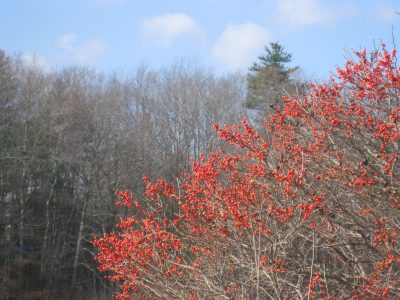
Looking for a splash of color in your yard amid winter’s dreary landscape? Check out one or more of the many winterberry (Ilex verticillata) cultivars. This deciduous member of the holly family sports bright, shiny red berries from early fall through late winter. Branches may be cut and used in holiday arrangements.
Winterberry can be found growing throughout eastern North America from Canada down along the east coast and west to Texas. Look for the brilliant red berries when driving past marshy areas in particular. While winterberry will grow in well-drained soil, it is a great candidate for areas that stay moist and aren’t particularly well drained. These plants naturally occur in forested wetlands as well as along the banks of streams, ponds or other water sources.
There are several factors to consider when selecting a winterberry bush for your yard. One of the most important is the mature size of the plant. Cultivars are available that vary from dwarf, 4-foot, compact plants to 15-foot, more rangy specimens. ‘Red Sprite’ and ‘Berry Poppins’ are two red-berried, compact cultivars. ‘Winter Red’ and ‘Sparkleberry’ typically top 10 feet. Check out suggested cultivars for Connecticut with the UConn Plant Database (https://plantdatabase.uconn.edu/). While initially slow growing, winterberries may eventually form clumps through suckering and depending on the cultivars, may form dense stands if allowed.
The berries on most cultivars are a brilliant red. There are, however, some that have gold or orange fruits. ‘Goldfinch’ boasts golden yellow berries while both ‘Aurantiaca’ and ‘Afterglow’ offer delightful orangey fruit.
Do realize that plants are dioecious, meaning that individual plants may be male or female. Only the female plants produce berries. The male plants supply the pollen to fertilize the female’s flowers so that berries are produced. One male plant can fertilize at least 10 females if located within 50 feet or closer. Look at tags so a compatible male cultivar is chosen. Appropriate pollinators should be listed on nursery tags.
Unless plants are in bloom or have berries, it is not possible to tell males from females, but they should be marked on their tags at the nursery. When in bloom, the female flowers have tiny green immature berries in the center while the males have fluffy, yellow, pollen-bearing anthers. Occasionally the female flowers have non-pollen bearing anthers, probably effective is luring pollinators to fertilize their flowers. Although not common in Connecticut, one native species of cellophane bee, Colletes banksi, is a specialized pollinator of winterberry.

Winterberries do best in full sun to partial shade. The shadier the site they are grown in, the fewer blossoms and berries they will produce. Being native New Englanders, they prefer acidic soils rich in organic matter. If your soil pH is between 5 to 6.5, plants should happily grow. Once plants are established, only minimal fertilization is usually required. For the first few years, about a cup of a complete organic or synthetic fertilizer could be lightly worked into the soil surrounding the plant each spring.
Plants can be used in foundation plantings, as a hedge, in rain gardens and when setting up areas attractive to wildlife. Not only are pollinators attracted to the flowers but over 48 species of birds feed on the berries, typically after they soften following periods of freezing and thawing.
Pruning can be tricky and is best kept to a minimum so selecting the right sized cultivar for your particular site is crucial. Winterberries have an upright growth habit but may sucker. They bloom on old wood meaning the flower buds that open in the spring were formed last fall. If grown as a multi-stemmed shrub, a few stems can be removed if plants seem crowded.
Complaints about little or no berry production may be due to lack of a male pollinator, too much shade, young plants that have not established a good root system, improper pruning or excessively dry conditions. In general, winterberries are rewarding, easy to grow shrubs that make quite the impact when little else in the landscape stands out.
For questions about selecting or growing winterberries or for other gardening queries, contact the UCONN Home & Garden Education Center, toll-free, at (877) 486-6271, visit their web site at www.homegarden.cahnr.uconn.edu or contact your local Cooperative Extension Center.